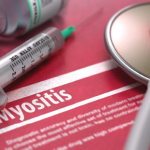Two patients ended up switching to the IVIG group in the randomized phase because of deterioration and another three were switched due to an error, researchers reported.
At week 16, at least minimal improvement—a TIS of at least 20—was seen in 79% of the IVIG patients and 44% in the placebo group (P<0.001). The average TIS at week 16 was 48 in the IVIG group and 21 in the placebo group.
The IVIG group did better regardless of disease severity. For those with mild disease activity, 73% receiving IVIG had at least a minimal response, compared with 27% in the placebo group; for those with moderate disease activity, 79% vs. 52%; and for those with severe disease activity, 86% vs. 50%. Researchers pointed out, though, that the trial was not powered to find differences between these subgroups.
At week 16, researchers found at least a moderate improvement—a TIS of at least 40—in 68% of the IVIG patients, compared with 23% of the placebo group. They found a major improvement—TIS of at least 60—in 32% of the IVIG group and 8% of the placebo group.
At the end of the open-label phase at week 40, the responses between the groups were similar, with 71% of those in the IVIG group who continued to receive IVIG having at least minimal improvement, and 70% of those who had received placebo but switched to IVIG having a response.
About 60% of patients in both groups had at least a moderate improvement at week 40, and more than 30% in both groups had a major improvement at week 40.
The time to at least minimal improvement was a median of 35 days in the IVIG group; to at least moderate improvement, 85 days for these patients; and to major improvement, 283 days in both trial groups.
During the randomized, placebo-controlled phase, deterioration was confirmed in three patients in the placebo group and no patients in the IVIG group. Researchers also found that, of the 85 patients taking concomitant glucocorticoids, 15 were able to reduce their dose or discontinue that treatment during the open-label extension phase. And among the 91 patients who entered the extension phase, eight had a reduction in the IVIG dose to 1 g/kg at 28 weeks or after.
Six thromboembolic events attributed to IVIG were seen in five patients, leading to a change in protocol—lowering the maximum infusion rate to 0.04 mL/kg per minute, from 0.12 mL/kg per minute. Afterward, the events were three times less frequent—the incidence fell from 1.54 per 100 patient-months before the change to 0.54 per 100 patient-months after.


